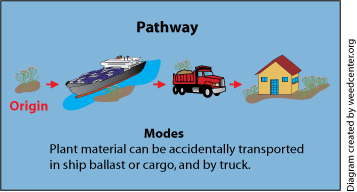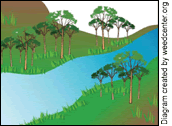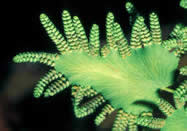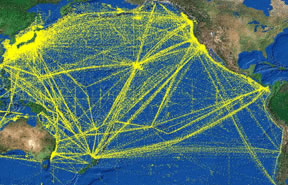Invasive Plants On The Move
In the last few hundred years, humans have broken down natural barriers and opened countless pathways for the movement of plants. With the advent of ships, trains, airplanes, and other high speed transportation, invasive plants are able to spread more quickly and farther than ever before. Even the Internet, through online sales, has helped increase the spread of invasive plants.
Around the world there have been both accidental and deliberate introductions of nonnative plants. The deliberate movement of plants has led to far more invasions than by accidental introductions. From the Romans to post-Columbian settlers to present day society, people have been the primary introducers of nonnative plant species.
Very few of the many plant species that are introduced will survive in their new environment if left on their own. Those that survive and become established may have no impact while others may become invasive, causing severe environmental damage and economic loss.

Knowing how invasive plants or their propagules (plant parts capable of reproducing on their own) are moved from one place to another is important for finding solutions to control their movements and prevent their establishment. Plants (and other organisms) move along what scientists call "pathways." A pathway is a route or a progression by which the plant is dispersed. The type of transportation that moves the plant is called the "mode" of travel.
Natural Pathways
Plants have always spread and increased their geographic range by moving along natural pathways. The diagram below shows three major natural pathways along which plant material such as seeds, spores, and other reproductive parts move.
Atmosphericblowing in the wind |
Oceanicfloating in the current |
Riverinefloating downstream |
||
|---|---|---|---|---|
 |
 |
 |
Natural pathways are not nearly as important as human-created pathways in the global spread of invasive plants, but they do play a small role.
 Enrolled leaf tissue on this Old World climbing fern leaflet contains the spores. Photo credit: P Greb/USDA ARS (left), A Ferriter/S Florida Water Mgmt. District (right), www.forestryimages.org |
 Old World climbing fern working its way up the trunks of cypress trees. |
For example, Old World climbing fern (Lygodium microphyllum) was first found in a plant nursery in the late 1950s. It is likely that this species was introduced, that is, moved along a human-created pathway. But, it also can spread along a natural pathway: atmospheric currents or wind. Old World climbing fern has infested many remote and pristine areas in Florida because its spores are spread by the wind (1).
HUMAN-CREATED PATHWAYS
The role of humans is much larger than that of natural pathways in the spread of invasive plants. Humans have broken down natural barriers and opened new pathways, allowing the rapid movement of species from one place to another.
GLOBAL MOVEMENTS

Commercial shipping patterns of the Pacific Ocean. Map credit: T Gilbert, World Meteorological Organization, and National Oceanic and Atmospheric Administration.
Whereas traveling across an ocean, or even a continent, used to be next to impossible, today people and invasive plants can move easily between any two locations on the globe. Plants are transported both purposefully and accidentally to new locations, but need the right environmental conditions to reproduce and become established.
Today, many global pathways of introductions are unknown or unclear. But, scientists agree that some pathways have led to the introduction of invasive plants.
| Trade |
|---|
|
| Tourism and Travel |
|---|
|
MOVEMENTS IN THE UNITED STATES

Transportation pathways
When plant propagules arrive within the United States, they can be moved accidentally or deliberately along many pathways by many modes through transportation. We expedite these movements from coast to coast, from state to state, from city to city, and beyond into native plant communities.
Not only do our transportation systems facilitate the movement of invasive plants, but numerous other pathways, some of which are surprising, help move them around too. No wonder invasive plants are showing up in unexpected places.
| Pathways of Invasive Plants |
|---|
 |
WANT TO KNOW MORE?
- Global Invasive Species Programme
> About invasive species > Ecology and management of IAS > Entry pathways - National Invasive Species Information Center
> Manager’s Took Kit > Vectors and Pathways - Commission for Environmental Cooperation
> Publications and Information Resources > Conservation of Biodiversity > Closing the Pathways of Aquatic Invasive Species across North America
References
- University of Florida, IFAS Extension. <http://edis.ifas.ufl.edu/AG122>. Accessed 2006 Nov 13.
- Mack RN, Simberloff D, Lonsdale WM, Evans H, Clout M, Bazzaz F. 2000. Biotic invasions: epidemiology, global consequences and control. Issues in Ecology: No. 5. Ecological Society of America. <http://www.esa.org/science_resources/issues/TextIssues/issue5.php>. Accessed 2006 Nov 16.
- Myers J, Bazely D. 2003. Ecology and Control of Introduced Plants. Cambridge (UK): University Press. 313 p.
- Mack RN. 2003. Global plant dispersal, naturalization, and invasion: pathways, modes, and circumstances. In: Ruiz GM, Carlton JT, editors. Invasive Species, Vectors and Management Strategies. Washington: Island Press. p 3-30.
- Groves RH, Boden R, Lonsdale WM. 2005. Jumping the garden fence: invasive garden plants in
Australia and their environmental and agricultural impacts. CSIRO report prepared for WWF-Australia. WWF-Australia, Sydney. 173 p. - Kurokawa S. 2001. Invasion of exotic weed seeds into Japan, mixed in imported feed grains. <http://www.agnet.org/library/eb/497>. Accessed 2007 April 2.



